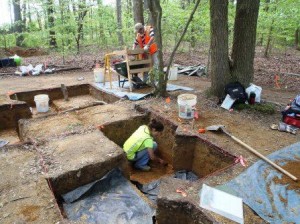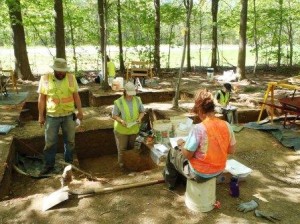

Facebook Twitter Flickr YouTube RSS Feed
Written on: May 14th, 2013 in Archaeology Updates US301

The previous post characterized the Warwick Site as a way station where small groups monitored game trails, sharpened tools, and consumed packed snacks, locally available foods, or both; ongoing excavation of the Warwick Site has reinforced this assessment. Nevertheless, the more robust view of the spatial distribution of artifacts across the site revealed by newly excavated test units highlights variation in the density and location of different types of artifacts and, perhaps, different activities, and has implications for the length and type of past occupations. Within the core of the site, for example, artifact density reached 30 to 65 artifacts per test unit, well above the amount recovered from most test units. In contrast, very few artifacts occurred in the southeastern test units, though several tools were unearthed in that area and a small basin-shaped pit was identified during the earlier work. The pit contained only charcoal and very small fragments of chipping debris that would have fallen through the screens used to standardize artifact collection. Microdebitage, the archaeological term for the very small chips recovered by passing the sediments from the feature through screens similar to mosquito mesh, may be one key to evaluating the way-station hypothesis.
Two ethnographic observations illustrate the value of microdebitage: 1) people maintain sleeping and common areas by relocating large debris to the unused portions of the landform; and 2) the extent of maintenance and the organization of space tend to correlate with length of stay at a location. While cleaning, people often overlook extremely small fragments of chipping debris. If, therefore, flintknappers sharpening tools created the artifact-rich core of the site, microdebitage should be present. The absence of very small debris implies that larger material was tossed or swept from the actual location where tools were manufactured. Similarly, if a dearth of microdebitage does not accompany the dearth of refuse in the southeastern corner of the excavation block, the proposed interpretation flounders. The presence of significant amounts of microdebitage in an artifact-poor area implies extensive cleaning around the pit feature. The level of maintenance and spatial organization implied by extensive cleaning of a living area suggests a longer-term occupation that required more extensive organization of the use of space than predicted by the way-station hypothesis. Consequently, samples collected from the test units will be screened through fine mesh and examined under low magnification to assess the presence and frequency of microdebitage in different portions of the site.
